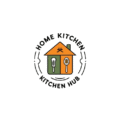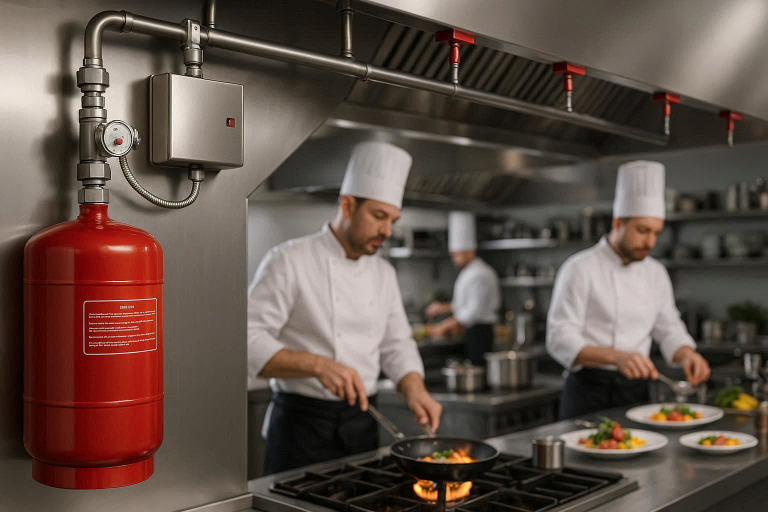Fire safety is one of the most important considerations for any commercial kitchen. The risks associated with cooking, combined with the high volume of activity and the use of flammable materials, make commercial kitchens particularly vulnerable to fires. A single spark from a cooking appliance or a grease fire can escalate quickly, potentially causing severe damage, injury, and even fatalities.
A commercial kitchen fire suppression system is one of the most effective ways to prevent and control fires in kitchens, ensuring the safety of both employees and customers. These systems are designed to quickly detect fires and suppress them before they escalate out of control, saving lives, property, and minimizing downtime a business might face in the event of an emergency.
In this guide, we’ll delve into everything you need to know about commercial kitchen fire suppression systems, including how they operate, the various types available, installation, maintenance, and more.
What is a Commercial Kitchen Fire Suppression System?
A commercial kitchen fire suppression system is a specialized system designed to detect, suppress, and extinguish fires in commercial kitchens. It’s designed to protect kitchen equipment, the kitchen itself, and the people working in the area by responding quickly to fire outbreaks.
Definition and Purpose
The primary purpose of a fire suppression system in a commercial kitchen is to detect fire hazards—such as high heat, smoke, or open flames—and activate an automatic mechanism to suppress the fire. This could involve discharging a fire-suppressing chemical, turning off the gas supply, or using water or foam to extinguish the fire.
Types of Fire Suppression Systems
There are several types of fire suppression Cleaning Guide for Home & Kitchen systems used in commercial kitchens, each designed for specific needs and scenarios. These include:
- Wet Chemical Systems: The most common type, used to suppress grease fires by discharging a wet chemical agent that cools the oil and forms a foam blanket to prevent re-ignition.
- Dry Chemical Systems: These use dry chemical powders to suppress fires, often used in areas where grease fires are not as common.
- Carbon Dioxide (CO2) Systems: These systems release CO2 to suffocate fires by displacing the oxygen.
- Automatic Sprinkler Systems: While not specifically designed for grease fires, sprinklers are an additional safety measure for other fire risks in the kitchen.
- Manual Fire Suppression: Manual systems can be used to add an extra layer of protection but require intervention to activate.
Components of the System
The components of a fire suppression system include:
- Nozzles: Strategically placed in high-risk areas to discharge the fire-suppressing agents.
- Tanks: Contain the chemicals or other fire-suppressing agents.
- Detectors: Smoke or heat detectors that activate the system when specific thresholds are reached.
- Control Panel: Allows monitoring of the system and gives control over its functions, ensuring proper activation.
Why is a Fire Suppression System Essential in a Commercial Kitchen?
A fire suppression system is not just a safety feature; it’s a necessity for any commercial kitchen. Here’s why:
High Fire Risk in Kitchens
Commercial kitchens are at high risk for fires due to the cooking processes that involve open flames, high heat, and combustible materials like oil, grease, and fat. The high concentration of electrical appliances, ovens, stoves, and fryers also presents a serious risk.
Grease fires are particularly hazardous, as they can spread quickly and are difficult to control with traditional fire extinguishers. A fire suppression system is designed to tackle these fires immediately, preventing further escalation.
Protecting Lives and Property
Fires in commercial kitchens can result in serious injuries or fatalities. A fire suppression system ensures that employees and customers are protected in the event of a fire. Moreover, it helps limit damage to expensive kitchen equipment, inventory, and the building itself.
Insurance Requirements
Many insurance providers require a fire suppression system to be installed in commercial kitchens in order to provide full coverage. Installing a fire suppression system can also help reduce insurance premiums, as it decreases the risk of fire-related claims.
Legal Compliance
Fire safety is regulated by local codes and standards, such as those set by the National Fire Protection Association (NFPA). Installing a fire suppression system ensures compliance with these regulations and avoids potential fines or legal consequences.
How Does a Commercial Kitchen Fire Suppression System Work?
A fire suppression system works in a few quick, coordinated steps to minimize the damage caused by fire outbreaks:
Automatic Activation
The system detects heat or smoke from a fire through specialized sensors or detectors. Once a threshold is reached, it triggers the system to automatically release fire-suppressing agents. This minimizes the response time, even in situations where kitchen staff might be too busy or unaware of the fire’s presence.
Chemical Agent Dispensing
In a wet chemical suppression system, the system releases a liquid agent designed to suppress grease and oil fires by cooling them and preventing re-ignition. The agents neutralize the fuel that is feeding the fire, and they help break the chain reaction, ultimately suppressing the fire.
Fire Extinguishing Process
The system’s nozzles strategically placed over stoves, fryers, grills, and hoods, spray the chemical agent directly onto the fire, extinguishing it quickly.
System Shutdown
Once the fire is suppressed, the system will automatically shut down the kitchen’s cooking equipment, preventing further damage and stopping the fire from reigniting. This automated response saves time and allows kitchen staff to focus on evacuating and securing the building.
Types of Commercial Kitchen Fire Suppression Systems
Several types of fire suppression systems can be used, depending on the needs of the kitchen and the types of hazards present.
Wet Chemical Fire Suppression System
- How it works: A wet chemical system is the most common in commercial kitchens. It uses liquid agents that quickly suppress grease fires by forming a foam blanket over the fuel source.
- Benefits: It’s effective in controlling grease and oil fires, easy to clean up, and less toxic than other chemicals.
- Why it’s common: It’s the standard for kitchens that cook with oil and grease, such as deep fryers.
Dry Chemical Fire Suppression System
- How it works: Dry chemical agents are released into the air to smother the fire, mainly used for non-grease-related fires.
- When it’s used: Primarily used in areas where grease fires are less likely (like storage areas or industrial kitchens).
- Limitations: It can cause residue buildup and is less effective against grease fires.
Automatic Sprinkler Systems
- How it works: Sprinklers activate when heat is detected, releasing water to suppress the fire.
- Role in commercial kitchens: While they’re great for fire safety, sprinklers are not as effective in commercial kitchens, particularly when it comes to grease fires.
Carbon Dioxide (CO2) Fire Suppression System
- How it works: CO2 systems work by displacing the oxygen in the area, effectively suffocating the fire.
- Advantages: CO2 is clean and doesn’t leave residue.
- Concerns: It can displace oxygen in the air, posing a danger to individuals in the area.
Key Features to Look for in a Commercial Kitchen Fire Suppression System
When selecting a fire suppression system, here are some key features you should prioritize:
Automatic Detection and Activation
A system that can detect fires early and activate immediately without manual intervention is crucial in ensuring quick suppression.
Quick Response Time
The quicker the system responds, the less damage will occur. Speed is of the essence when it comes to fire suppression.
Complete Coverage
The system should cover all critical areas, including cooking equipment, exhaust systems, and ventilation hoods.
Ease of Maintenance
Systems that are easy to inspect and maintain ensure they will work when needed without issues.
Compliance with Standards
Ensure the system meets local and national safety regulations, including those set by the NFPA.
Remote Monitoring
In larger commercial kitchens, remote monitoring allows owners or managers to monitor the system even when they are not physically present.
Installation of a Commercial Kitchen Fire Suppression System
Installing a fire suppression system is not something that should be done as a DIY project. It requires professional expertise to ensure the system is properly installed and operates as intended.
Professional Installation
Certified technicians should handle the installation of the system to ensure compliance with local codes and the manufacturer’s guidelines.
System Design and Planning
The system should be designed according to the specific needs of your kitchen, taking into account the layout, equipment, and risk factors.
Placement of Components
Proper placement of nozzles, tanks, and detectors is crucial to ensure maximum protection.
Inspection and Testing
Post-installation, a certified technician should test the system to ensure it is working correctly and that all components are properly functioning.
Cost of Commercial Kitchen Fire Suppression Systems
The cost of a fire suppression system can vary depending on various factors, including the size of the kitchen, the type of system, and installation complexity.
Initial Costs
On average, the cost for a commercial kitchen fire suppression system can range from $2,000 to $10,000, depending on the system’s size and complexity.
Ongoing Maintenance Costs
Maintenance typically costs $300 to $600 per year, including inspections, refills, and any necessary repairs or upgrades.
Long-Term Benefits
The investment in a fire suppression system can save significant amounts of money by preventing fire damage, reducing insurance premiums, and ensuring business continuity after a fire.
Maintenance and Inspection of Fire Suppression Systems
Regular maintenance and inspection are essential to ensure your fire suppression system continues to function properly.
Regular Inspections
Your system should be inspected every 6 months to a year, depending on usage and local regulations.
Refills and Recharging
After activation, the system will need to be recharged with the proper chemical agents to be ready for future use.
Servicing Components
Routine checks should be conducted to ensure that nozzles, tanks, and detectors are functioning correctly and free from blockages.
Updating the System
As your kitchen evolves, the fire suppression system may need to be updated to meet new regulations or accommodate new equipment.
FAQ
What is the best type of fire suppression system for my commercial kitchen?
It depends on your cooking methods and kitchen layout. For most kitchens, a wet chemical suppression system is the best choice for grease fires.
How often does a commercial kitchen fire suppression system need maintenance?
It should be inspected and serviced every 6 months to a year.
Can a fire suppression system be installed in an existing kitchen?
Yes, it’s often possible to retrofit a fire suppression system into an existing kitchen setup.
What happens if my fire suppression system activates during cooking?
Follow the system’s manual to handle the activation safely. Staff should be trained to respond quickly and correctly.
How long does it take to install a commercial kitchen fire suppression system?
Installation can take a few days to a week, depending on the size of the kitchen.
Conclusion
A commercial kitchen fire suppression system is an essential investment in fire safety, offering peace of mind for kitchen owners, staff, and customers alike. By choosing the right system, maintaining it properly, and ensuring it complies with local regulations, you can protect your business from the devastating effects of fire.
If you’re ready to install or upgrade your fire suppression system, consult with a fire safety professional to make sure you meet all necessary standards and have a system tailored to your kitchen’s specific needs. Don’t wait until it’s too late—act now to keep your kitchen safe and secure!

